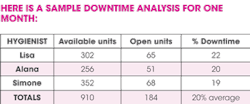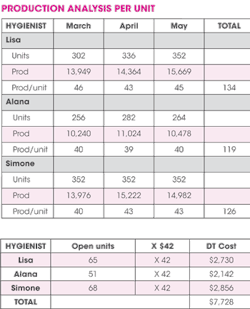Measuring Downtime
by Dianne Glasscoe Watterson, RDH, BS, MBA
Dear Dianne,
I have been a hygienist in my current practice for five years. Over the past year, I have noticed an increase of open time in my schedule. The doctor must have noticed it too, because he has mentioned to me that he may need to cut my hours back! I'm terrified at the thought of having my hours reduced, since I'm barely paying all my bills now. When I do have open time, I make myself useful by helping anywhere I can. I'll do anything, including scrubbing the toilet. Jobs for hygienists are scarce in my area, and I dread the thought of trying to find an additional day or two somewhere else. Can you give me any tips on keeping the schedule full? I feel like I'm nearing desperation!
Mandy, RDH
Dear Mandy,
Some dental practices have seen their demand for services decrease steadily since the recession hit a few years back. Especially hard hit have been practices with large numbers of patients that are insurance-dependent who have lost their jobs and now have no third-party dental benefits.
Interestingly, some practices are flourishing. Owners who have managed well and invested in effective marketing are doing just fine. One of my clients in a rural area had her best month ever last month. It's hard for me to understand why some doctors are not willing to invest one red cent toward marketing but are willing to spend megabucks on some new dental technology. Gone are the days when a dentist could merely hang out his or her shingle and keep the schedule full without any marketing endeavors.
---------------------------------------------------
Other articles by Dianne Watterson
---------------------------------------------------
Downtime problems are not always caused by a decrease in demand, however. One problem is being understaffed at the business desk. If the office is understaffed, it is sure to underproduce. As a consultant, I've seen situations in which there were 500 or more patients who had fallen through the cracks for various reasons. The lone business assistant was so swamped trying to keep up with the telephone and insurance concerns, plus all the check-in/check-out duties and other demands at the business desk, that she had no time to work on reactivation efforts. It takes uninterrupted time to work on reactivation.
Some practices have ineffective recall systems and untrained or unmotivated business assistants. It has to be part of somebody's job description to maintain the hygiene and doctor schedules. If you think about it, there is nothing more important than scheduling -- not even collections. If you do not have warm bodies in chairs, there's nothing to collect. Working the unscheduled or past-due list has to be a priority. In one office I visited, I asked the business assistant to show me the report that shows all the active patients in the practice without an appointment. She informed me that their system would not produce such a report. That list is a critical tool in the hands of the scheduling coordinator. The only way the assistant could find overdue patients was to "mine" the charts, a laborious and time-consuming task. Staff members cannot do their jobs without the proper tools. One of my recommendations to the doctor was to change to a practice management software program with more capability in producing needed reports.
In your situation, it is unknown if the open time is a result of patient base attrition, not enough new patients, poor systems at the business desk, or unmotivated staff members. It could be a combination of all four reasons.
Do you know your downtime percentage rate? In order to know, downtime has to be tracked. Here's how to do that:
- Tally all the available units of time that the hygienist is available to see patients in one month. If the practice is on a 15-minute time increment, there will be four time units in an hour. An 8-5 day with an hour for lunch would mean 32 time units per day. If the office is on a 10-minute time increment, there are six units in an hour. An 8-5 day would have 48 time units.
- Tally all the open time units in the schedule. Do not count lunch as open time. Also, do not count time that has been blocked off for training or staff meetings.
- Divide the available unit total into the open time unit total (big number into the small number). Move the decimal two places to the right. This is the downtime percentage. Round up anything that is .5 or higher.
We know that the average downtime cost to the practice for one month was almost $8,000. If this is multiplied over 12 months, the average raw cost of downtime would be $96,000 in a year. However, the costs do not stop there. There was also the cost of hygienist's hourly pay (being paid when she is not producing) and the loss of any restorative dentistry that may have been diagnosed.
As you can see from our example, downtime is very costly and can destroy a practice's profitability. The good news is that for every problem, there is a solution.
In order to correct the situation, you need to track and analyze downtime. After all, how can you know where you are going if you don't know where you've been? If demand for services has fallen, the doctor can either reduce your hours or engage in some effective marketing to increase the number of new patients. It would be advantageous for the practice to concentrate on reactivating unscheduled patients and improve the show rate through better communication. Is the business desk understaffed? Does the business assistant need some training in systems or better communication? Does she understand the importance of proper scheduling? Is she motivated to improve?
All businesses go through cycles, but smart business owners know they have to change with the times. Implementing needed change at the business desk can breathe new life into a dental practice. Sitting back and waiting for things to get better rarely ever works. When the going gets tough, the tough get going! RDH
All the best,
Dianne
The acceptable downtime goal should be 5% or less. As you can see from this example, this practice has excessive downtime.
Now let's analyze the cost of this particular month's downtime. First, we have to arrive at the average production over a period of time.
By dividing the number of units into the total production, we can compute the dollar amount of each unit of time. Then, add 134 + 119 + 126 = 379 / 3 hygienists = $126 / 3 months = $42. We know, based on a three-month average, that an average unit of time is worth $42.
DIANNE GLASSCOE WATTERSON, RDH, BS, MBA, is a professional speaker, writer, and consultant to dental practices across the United States. Dianne's new book, "The Consummate Dental Hygienist: Solutions for Challenging Workplace Issues," is now available on her website. To contact her for speaking or consulting, call (301) 874-5240 or email dglass [email protected]. Visit her website at www.professionaldentalmgmt.com.
Past RDH Issues


